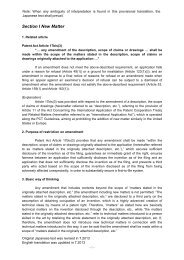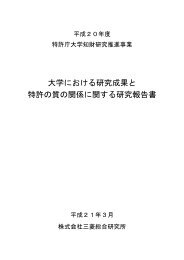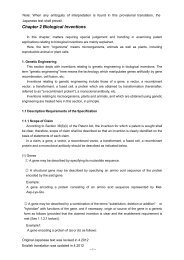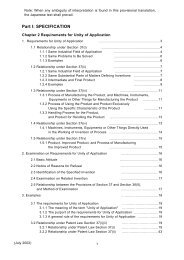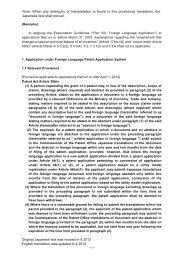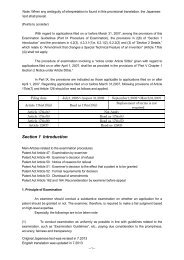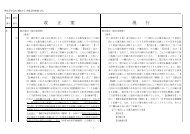Chapter 2 Novelty and Inventive Step - Japan Patent Office
Chapter 2 Novelty and Inventive Step - Japan Patent Office
Chapter 2 Novelty and Inventive Step - Japan Patent Office
Create successful ePaper yourself
Turn your PDF publications into a flip-book with our unique Google optimized e-Paper software.
Part II <strong>Chapter</strong> 2 <strong>Novelty</strong> <strong>and</strong> <strong>Inventive</strong> <strong>Step</strong><br />
claimed invention from application or a combination of the cited inventions.<br />
[Example 1] Both the cited invention 1 <strong>and</strong> the cited invention 2 are common in respect of<br />
pressing cloth for washing cylinders of the printing machines <strong>and</strong> have no difference between the<br />
cam mechanism of the cited invention 1 <strong>and</strong> the expansion member of the cited invention 2 in<br />
respect that the cloth is placed for attaching to or detaching from the cylinder. Then, it could be<br />
said that there is a background of conversion of a pressure means in place of the cam<br />
mechanism of the cited invention 1 to the expansion member of the cited invention 2.<br />
(Reference: Decision by the Tokyo High Court, October 15, 1998 [Heisei 8 (Gyo Ke) 262])<br />
IV. Implications in the cited inventions<br />
Implications shown in the cited inventions relevant to the claimed invention are strong<br />
grounds for the reasoning that a person skilled in the art could derive the claimed invention from<br />
the cited inventions.<br />
[Example 1] The cited document discloses metal ions, which are cation, <strong>and</strong> provided for<br />
gaining aqueous electrodeposition baths that do not require chemical pretreatments, which is also<br />
similar to the purpose of the claimed invention, under the condition that the electrical potential of<br />
the galvanic series is higher than that of iron, providing seven types of metal ions as examples.<br />
These examples do not include lead ions as a constitution defining the claimed invention, but it is<br />
publicly known that the electrical potential of the galvanic series of lead is higher than that of iron,<br />
which shows that the applying lead ions is implied in the cited example. Accordingly, adding iron<br />
ions to aqueous electrodeposition baths is an idea that a person skilled in the art could conceive<br />
easily unless specific circumstance exists, such as inappropriateness of using iron ions in the<br />
claimed invention for achieving the purpose of the invention.<br />
(Reference: Decision by the Tokyo High Court, November 18, 1987 [Showa 61 (Gyo Ke) 240])<br />
[Example 2] A claimed invention providing a 3-chloro group does not mention the difference<br />
of the substitution position in the chemical formula between the 2-chloro group <strong>and</strong> 4-chloro<br />
group nor the positional limitation for displacing <strong>and</strong> using the compound to a color brightener,<br />
which are described in the cited document. Accordingly, it is understood that the 3-chloro group is<br />
implied in the cited document, which reveals that a person skilled in the art could easily predict<br />
that the 3-chloro group is also valuable to be used as a color brightener.<br />
(Reference: Decision by the Tokyo High Court, March 30, 1978 [Showa 51 (Gyo Ke) 19])<br />
(3) Effects more advantageous to the claimed inventions than the cited inventions<br />
Advantageous effects of the claimed inventions explicitly described in the specifications etc. are<br />
taken into consideration as a fact used for positively confirming the presence of the inventive step<br />
in the inventions. “Advantageous effects” means effects more advantageous to the claimed<br />
inventions than the cited inventions, selected from effects or particular effects derived from the<br />
matters used to specify the claimed inventions.<br />
I. Analyzing effects more advantageous to the claimed inventions than the cited inventions<br />
The effects more advantageous to the claimed inventions than the cited inventions are<br />
attempted to be analyzed for reasoning that a person skilled in the art could have easily arrived at<br />
the claimed inventions, <strong>and</strong> the inventive step of the claimed inventions is denied when the fact<br />
that the a person skilled in the art could have easily arrived at the claimed inventions is<br />
sufficiently reasoned, regardless of the presence of the advantageous effects.<br />
21



